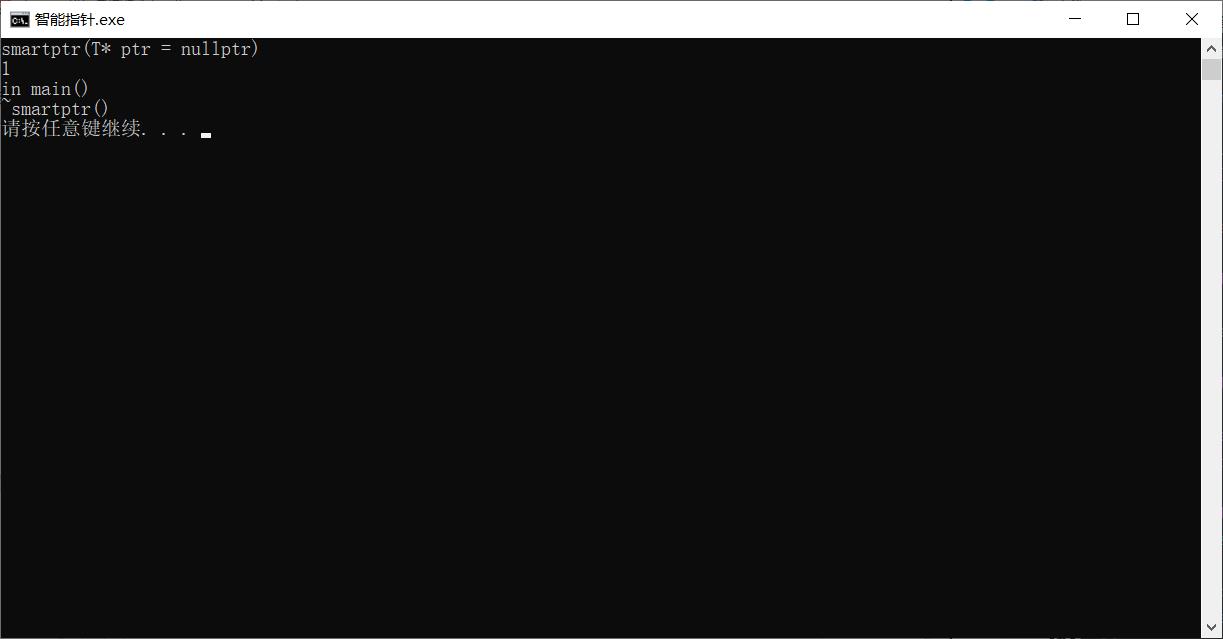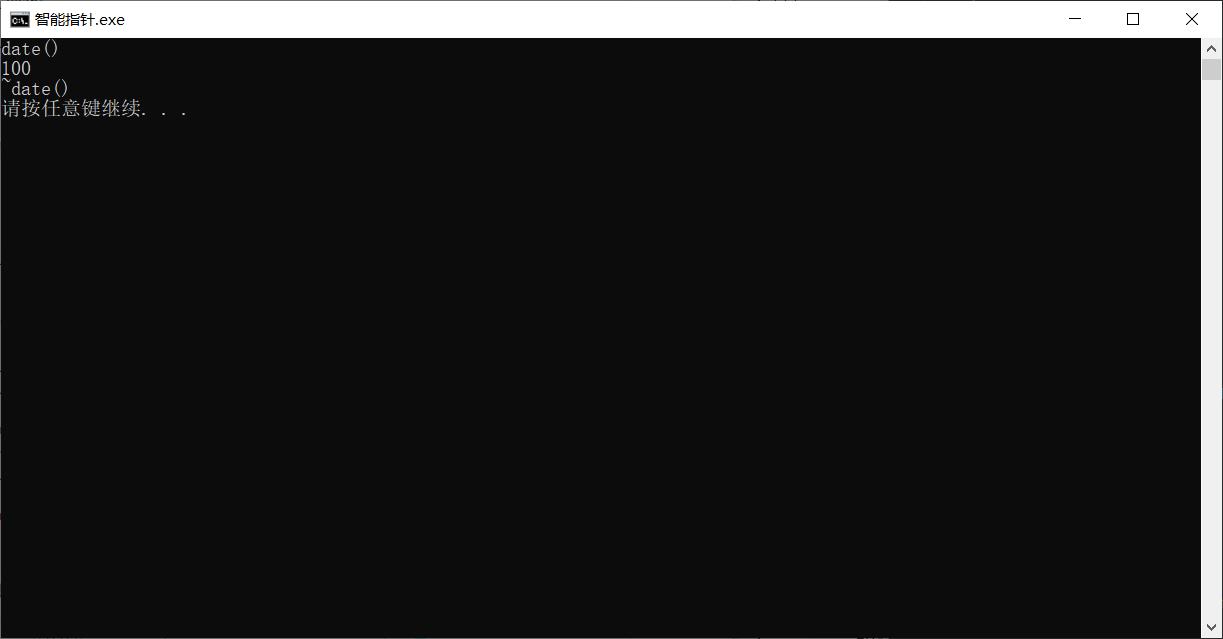C++智能指针以及自我实现
Posted 遥远的歌s
tags:
篇首语:本文由小常识网(cha138.com)小编为大家整理,主要介绍了C++智能指针以及自我实现相关的知识,希望对你有一定的参考价值。
为什么需要智能指针
我们知道,内存泄漏是一件非常严重的错误,这要求如果malloc内存就一定要有对应的free,new了内存也一定要有对应的delete。但是如果程序员忘记写上对应的释放空间的操作符或者函数,那么就会出现内存泄漏,或者程序员写上了,但是中间某个逻辑导致程序崩溃了,并没有走释放空间的语句,那么也会造成内存泄漏,因此,为了防止内存泄漏的发生,C++11中引入了智能指针来管理空间。
-
内存泄漏
什么是内存泄漏:内存泄漏指因为疏忽或错误造成程序未能释放已经不再使用的内存的情况。内存泄漏并不是指内存在物理上的消失,而是应用程序分配某段内存后,因为设计错误,失去了对该段内存的控制,因而造成了内存的浪费。
内存泄漏的危害:长期运行的程序出现内存泄漏,影响很大,如操作系统、后台服务等等,出现内存泄漏会导致响应越来越慢,最终卡死。
void MemoryLeaks()
// 1.内存申请了忘记释放
int* p1 = (int*)malloc(sizeof(int));
int* p2 = new int;
// 2.异常安全问题
int* p3 = new int[10];
Func(); // 这里Func函数抛异常导致 delete[] p3未执行,p3没被释放.
delete[] p3;
- 内存泄漏分类
堆内存泄漏(Heap leak)
堆内存指的是程序执行中依据须要分配通过malloc / calloc / realloc / new等从堆中分配的一块内存,用完后必须通过调用相应的 free或者delete 删掉。假设程序的设计错误导致这部分内存没有被释放,那么以后这部分空间将无法再被使用,就会产生Heap Leak。
系统资源泄漏
指程序使用系统分配的资源,比方套接字、文件描述符、管道等没有使用对应的函数释放掉,导致系统资源的浪费,严重可导致系统效能减少,系统执行不稳定。
智能指针的使用及原理
- RAII
RAII(Resource Acquisition Is Initialization)是一种利用对象生命周期来控制程序资源(如内存、文件句柄、网络连接、互斥量等等)的简单技术。
在对象构造时获取资源,接着控制对资源的访问使之在对象的生命周期内始终保持有效,最后在对象析构的时候释放资源。借此,我们实际上把管理一份资源的责任托管给了一个对象。这种做法有两大好处:- 不需要显式地释放资源。
- 采用这种方式,对象所需的资源在其生命期内始终保持有效。
利用上述RAII思想先写一个类似智能指针一样的类如下:
template<class T>
class smartptr
public:
smartptr(T* ptr = nullptr)
:_ptr(ptr)
cout<<"smartptr(T* ptr = nullptr)"<<endl;
~smartptr()//析构时释放空间
cout<<"~smartptr()"<<endl;
delete _ptr;
private:
T* _ptr;
;
int main()
smartptr<int> sp(new int(1));
cout<<"in main()"<<endl;
结果如下图:

即使我没有delete这个空间,但是通过smartptr这个类进行管理,则能够正确的释放这块空间,不过上面这个类还不是一个完整的智能指针,因为指针还应该具解引用和->操作去访问所管理空间的内容因此只需加以改造就可以实现一个最简单的智能指针。
template<class T>
class smartptr
public:
smartptr(T* ptr = nullptr)
:_ptr(ptr)
cout<<"smartptr(T* ptr = nullptr)"<<endl;
~smartptr()//析构时释放空间
cout<<"~smartptr()"<<endl;
delete _ptr;
T*operator ->()
return _ptr;
T&operator*()
return *_ptr;
private:
T* _ptr;
;
int main()
smartptr<int> sp(new int(1));
cout<<*sp<<endl;
cout<<"in main()"<<endl;
运行结果如下:

C++中提供的一系列智能指针
1.auto_ptr
C++98版本的库中就提供了auto_ptr的智能指针,用法如下:
class date
public:
date()
cout<<"date()"<<endl;
~date()
cout<<"~date()"<<endl;
public:
int _day;
;
void test_auto_ptr()
auto_ptr<date> ap(new date);
ap->_day = 100;
cout<<ap->_day<<endl;
运行结果如下:

auto_ptr的问题:当对象拷贝或者赋值后,前面的对象就悬空了
比如上述代码中test_auto_ptr函数改为如下:
void test_auto_ptr()
auto_ptr<date> ap(new date);
ap->_day = 100;
auto_ptr<date> copy(ap);//此操作后,ap智能指针就被悬空了,相当于管理这块空间的权限交给了copy,因此会有解引用问题
cout<<copy->_day<<endl;
//cout<<ap->_day<<endl; 存在解引用操作问题
自我实现
template<class T>
class my_auto_ptr
public:
my_auto_ptr(T* ptr = nullptr)
:_ptr(ptr)
T&operator*()
return *_ptr;
T*operator->()
return _ptr;
my_auto_ptr(my_auto_ptr<T> &ap)
this._ptr = ap._ptr;
ap._ptr = nullptr;
my_auto_ptr<T>&operator = (my_auto_ptr<T>& ap)
if(this != &ap)
if(this._ptr)
delete this._ptr;
this._ptr = ap._ptr;
ap._ptr = nullptr;
return *this;
~my_auto_ptr()
if(this._ptr)
delete this._ptr;
private:
T* _ptr;
;
2.unique_ptr
由于auto_ptr的严重缺陷,C++11中提供了可靠的auto_ptr智能指针,因为auto_ptr中可能会存在拷贝的问题,因此unique_ptr中将拷贝和赋值两个函数置为delete,即防拷贝
void test_unique_ptr()
unique_ptr<date> up(new date);
//unique_ptr<date> copy(up);防拷贝
//unique_ptr<date> up1 = up;防赋值
自我实现
template<class T>
class my_unique_ptr
public:
my_unique_ptr(T* ptr = nullptr)
:_ptr(ptr)
~my_unique_ptr()
if(_ptr)
delete _ptr;
T& operator*() return *_ptr;
T* operator->() return _ptr;
private:
my_unique_ptr(my_unique_ptr<T> const &) = delete;
my_unique_ptr<T>& operator=(my_unique_ptr<T> const &) = delete;
private:
T* _ptr;
;
3.shared_ptr
C++11中开始提供更靠谱的并且支持拷贝的shared_ptr。
int main()
// shared_ptr通过引用计数支持智能指针对象的拷贝
//use_count()为显示引用计数的个数,即当前由多少个智能指针对象再管理这份资源
shared_ptr<Date> sp(new date);
shared_ptr<Date> copy(sp);
cout << "ref count:" << sp.use_count() << endl;
cout << "ref count:" << copy.use_count() << endl;
return 0;
shared_ptr的原理:是通过引用计数的方式来实现多个shared_ptr对象之间共享资源。例如学校老师晚上在下班之前都会通知,让最后走的学生记得把灯关掉。
- shared_ptr在其内部,给每个资源都维护了着一份计数,用来记录该份资源被几个对象共享。
- 在对象被销毁时(也就是析构函数调用),就说明自己不使用该资源了,对象的引用计数减一。
- 如果引用计数是0,就说明自己是最后一个使用该资源的对象,必须释放该资源;
- 如果不是0,就说明除了自己还有其他对象在使用该份资源,不能释放该资源,否则其他对象就成野指针了。
shared_ptr的线程安全问题 - 智能指针对象中引用计数是多个智能指针对象共享的,两个线程中智能指针的引用计数同时++或–,这个操作不是原子的,引用计数原来是1,++了两次,可能还是2.这样引用计数就错乱了。会导致资源未释放或者程序崩溃的问题。所以只能指针中引用计数++、–是需要加锁的,也就是说引用计数的操作是线程安全的。
- 智能指针管理的对象存放在堆上,两个线程中同时去访问,会导致线程安全问题。
自我实现
template<class T>
class sharedptr
public:
sharedptr(T* ptr)
:_ptr(ptr)
,_usecount(new int(1))
,_mtx(new mutex)
~sharedptr()
if(subref() == 0)
delete _ptr;
delete _usecount;
delete _mtx;
cout<<"sharedptr"<<endl;
sharedptr(const sharedptr<T>& sp)
:_ptr(sp._ptr)
,_usecount(sp._usecount)
,_mtx(sp._mtx)
//++(*_usecount);
addref();
sharedptr<T>& operator = (const sharedptr<T>& sp)
//f(this != &sp)
if(_ptr != sp._ptr)
if(subref() == 0)
delete _ptr;
delete _usecount;
delete _mtx;
_ptr = sp._ptr;
_usecount = sp._usecount;
_mtx = sp._mtx;
//++(*_usecount);
addref();
return *this;
int addref()//上锁
_mtx->lock();
++(*_usecount);
_mtx->unlock();
return *_usecount;
int subref()//解锁
_mtx->lock();
--(*_usecount);
_mtx->unlock();
return *_usecount;
int use_count()
return *_usecount;
private:
T* _ptr;
int *_usecount;
mutex* _mtx;
;
这里可以测试一下
void func(sharedptr<int> sp,int n)
for(int i = 0;i<n;i++)//一直进行拷贝构造
sharedptr<int> copy(sp);
void test_thread()
sharedptr<int> sp(new int(1));
int n = 0;
cin>>n;//输入循环次数
//两个线程
thread t1(func,sp,n);
thread t2(func,sp,n);
t1.join();
t2.join();
cout<<sp.use_count()<<endl;
int main()
test_thread();
我们键入100000运行结果如下:

如果将上述的上锁和解锁去掉,我们再次执行下述代码
template<class T>
class sharedptr
public:
sharedptr(T* ptr)
:_ptr(ptr)
,_usecount(new int(1))
,_mtx(new mutex)
~sharedptr()
//if(subref() == 0)
if(--(*_usecount) == 0)
delete _ptr;
delete _usecount;
delete _mtx;
cout<<"sharedptr"<<endl;
sharedptr(const sharedptr<T>& sp)
:_ptr(sp._ptr)
,_usecount(sp._usecount)
,_mtx(sp._mtx)
//++(*_usecount);
addref();
sharedptr<T>& operator = (const sharedptr<T>& sp)
//f(this != &sp)
if(_ptr != sp._ptr)
//if(subref() == 0)
if(--(*_usecount) == 0)
delete _ptr;
delete _usecount;
delete _mtx;
_ptr = sp._ptr;
_usecount = sp._usecount;
_mtx = sp._mtx;
++(*_usecount);
//addref();
return *this;
/*int addref()
_mtx->lock();
++(*_usecount);
_mtx->unlock();
return *_usecount;
*/
*/int subref()
_mtx->lock();
--(*_usecount);
_mtx->unlock();
return *_usecount;
*/
int use_count()
return *_usecount;
private:
T* _ptr;
int *_usecount;
mutex* _mtx;
;
void func(sharedptr<int> sp,int n)
for(int i = 0;i<n;i++)
sharedptr<int> copy(sp);
void test_thread()
sharedptr<int> sp(new int(1));
int n = 0;
cin>>n;
thread t1(func,sp,n);
thread t2(func,sp,n);
t1.join();
t2.join();
cout<<sp.use_count()<<endl;
int main()
test_thread();
cout<<"in main()"<<endl;
运行结果:这是引用计数的值不对,从而导致没有释放空间

多次运行还会出现下述问题:程序直接崩溃掉

shared_ptr的循环引用
struct ListNode
int _data;
shared_ptr<ListNode> _prev;
shared_ptr<ListNode> _next;
~ListNode() cout << "~ListNode()" << endl;
;
int main()
shared_ptr<ListNode> node1(new ListNode);
shared_ptr<ListNode> node2(new ListNode);
cout << node1.use_count() << endl;
cout << node2.use_count() << endl;
node1->_next = node2;
node2->_prev = node1;
cout << node1.use_count() << endl;
cout << node2.use_count() << endl;
return 0;
分析:
- node1和node2两个智能指针对象指向两个节点,引用计数变成1,我们不需要手动delete。
- node1的_next指向node2,node2的_prev指向node1,引用计数变成2。
- node1和node2析构,引用计数减到1,但是_next还指向下一个节点。但是_prev还指向上一个节点。
- 也就是说_next析构了,node2就释放了。
- 也就是说_prev析构了,node1就释放了。
- 但是_next属于node的成员,node1释放了,_next才会析构,而node1由_prev管理,_prev属于node2成员,所以这就叫循环引用,谁也不会释放
如下图解:

解决方案:在引用计数的场景下,把节点中的_prev和_next改成weak_ptr就可以了
原理:node1->_next = node2;和node2->_prev = node1;时weak_ptr的_next和_prev不会增加node1和node2的引用计数。
struct ListNode
int _data;
weak_ptr<ListNode> _prev;
weak_ptr<ListNode> _next;
~ListNode() cout << "~ListNode()" << endl;
;
int main()
shared_ptr以上是关于C++智能指针以及自我实现的主要内容,如果未能解决你的问题,请参考以下文章